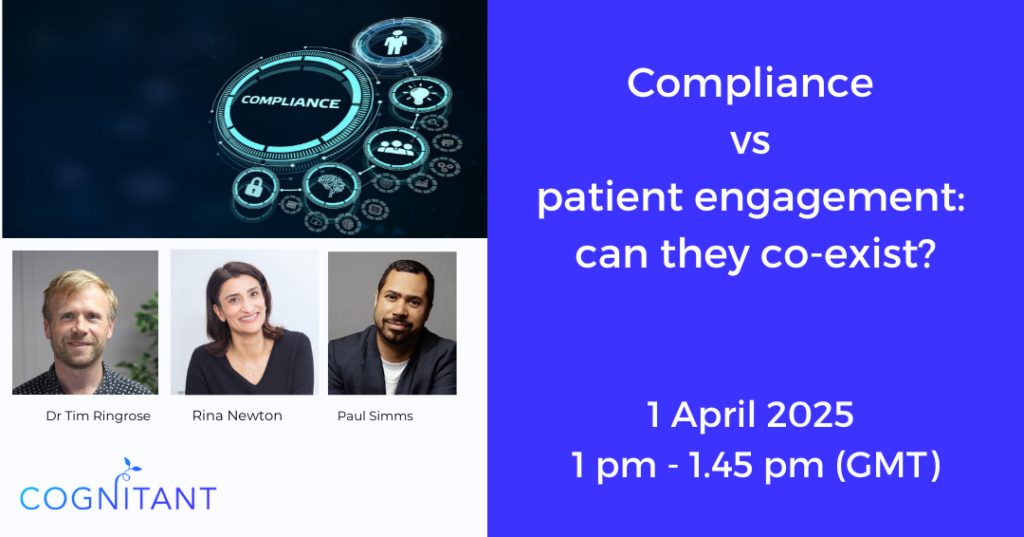Is compliance really a barrier to meaningful patient engagement in pharma, or are outdated myths holding us back?
In this recent webinar, Dr Tim Ringrose, CEO of Cognitant, brought together compliance expert Rina Newton (Code Clarity) and pharma provocateur Paul Simms (Impatient Health) to tackle one of the industry’s most persistent tensions: how to engage patients meaningfully while staying within the regulatory lines.

Defining Patient Engagement: A Misunderstood Concept
One of the core issues raised was the inconsistent understanding of what “patient engagement” really means. Paul Simms highlighted that it’s often reduced to a token gesture – “We do it because it’s the right thing to do… to kind of tick the box and say we’ve done it. But I think there’s very little substance behind that.”
Rina Newton added that compliance codes, such as the ABPI, define “patients” in strict terms “When you look at the ABPI Code, and indeed other codes globally, they talk about engaging with patients, but they define patients as people who are already taking your medicine.” This, she argued, “has led to confusion and hesitation around patient engagement initiatives.”
She also emphasised how patient engagement has evolved. Fifteen years ago, direct interaction with patients was widely considered non-compliant. As Rina Newton explained, many believed that – “In the past, pharma staff were not allowed to engage directly with patients as it was thought to be promotional” Although today many companies have dedicated patient engagement roles, in practice the shift has been minimal. As Rina observed, “Functions exist to interact with patients, but patient support is still very limited.”
She pointed to the need for a mindset shift, adding, “The future, however, should involve individuals interacting with patients—on stands, at meetings, in conversations, providing a service, showing them materials, and asking for advice.”

The Compliance Conundrum: Myths and Misconceptions
A major barrier to effective patient engagement is the perception that compliance regulations prohibit it.
Myths such as “We can’t engage with patients directly” and “ROI on patient engagement can’t be measured” are often repeated. However, as Rina pointed out, “When people say, ‘Compliance won’t let me,’ it’s often not actually in the Code – it’s just something that’s become culture….Many professionals default to ‘compliance says no’ without actually verifying the rule’s origin or intent.”
Paul illustrated this with the “five monkeys” analogy, where long-standing but outdated policies persist simply because “it has always been done this way.” He emphasised the need for companies to “actively question these self-imposed restrictions rather than blindly following inherited rules.” He reinforced this by stating, “We have this idea in pharma that if it hasn’t been done before, then it’s probably non-compliant. And that really holds us back.”
Tim Ringrose called for compliance teams to be seen as enablers – “Let’s start thinking about compliance as enabling, and as helping.”
Why Patient Engagement Matters for Pharma
The group discussed the importance of genuine patient engagement, not just from an ethical standpoint but as a business imperative. Several key benefits were discussed:
- Improved Patient Outcomes: “Patients who feel heard and involved are more likely to adhere to treatment plans, leading to better health outcomes.”
- Trust and Reputation: “Trust in the pharmaceutical industry surged during the COVID-19 pandemic but has since declined. Engaging with patients transparently can help rebuild credibility.”
- Better Product Development: “Incorporating patient insights can lead to better-designed treatments, services, and materials that truly meet patient needs.”
- Regulatory and Market Advantages: “While patient engagement is not always a prerequisite for market access, regulatory agencies are increasingly valuing patient input. Companies that excel in this area may gain competitive advantages.”
How Can Pharma Get it Right?
The panelists discussed several practical steps that pharma companies can take to improve patient engagement without violating compliance rules:
- Challenge Internal Policies: “Companies should create task forces to review and update internal regulations that may be unnecessarily restrictive.”
- Foster Leadership Buy-In: “Patient engagement must be a priority at the executive level to ensure meaningful action rather than lip service.”
- Empower Compliance Teams as Allies: “Instead of being seen as barriers, compliance professionals should be viewed as facilitators who help navigate regulatory frameworks.”
- Normalise Patient Involvement: “Engaging patients should be woven into the fabric of company culture, not relegated to a single department.”
Paul also highlighted Cognitant as an example of how patient support can be both compliant and highly effective: “If you look at Cognitant – they’re doing things that are engaging, compliant, and actually helping patients. It proves that it’s possible when you challenge assumptions and design with patients in mind.”
He highlighted a common pitfall in pharma’s approach to compliance:
“What happens in pharma is that the team comes up with an idea, they go through all this work, and then they get to final sign-off… only then do they involve compliance. And that’s completely the wrong way around.”
Instead, he argued, compliance should be part of the creative process from the very beginning: “We think compliance is something that happens at the end – like a stamp of approval – but if you don’t involve them early, you risk having to throw everything away.”
Rina Newton added that measuring success also requires a mindset shift. While traditional ROI might not apply to non-promotional tools, their value can still be clearly demonstrated: “You can’t always measure ROI in a traditional sense, especially for non-promotional materials, but if you look at patient outcomes, you absolutely can justify them.”
Final Thoughts: Compliance as a Catalyst
By redefining patient engagement, dismantling unnecessary compliance myths, and fostering a company-wide commitment to patient-centred thinking, the pharmaceutical industry can create a future where trust, transparency, and improved health outcomes go hand in hand.
Paul closed with a powerful statement: “Compliance is not the enemy. It’s there to protect patients and do the right thing.” He added, “Safe is sometimes wasteful. Safe is sometimes not the right thing to do.”
The message was clear: Pharma must stop treating patient engagement as an afterthought or a compliance risk – it is a strategic necessity. The challenge now is for industry leaders to take action and make this shift a reality.
Cognitant
Looking to empower people with health information for better patient outcomes?
Related News
Kidney Research UK invests in Healthinote patient education platform which could support >15m people with long term health conditions
April, 2025
Oxford, January 2025 – Kidney Research UK, the leading charity dedicated to kidney health, has made a significant investment in Cognitant Group Ltd, a leading...
Funding awarded to innovations that support early diagnosis and rehabilitation of Stroke patients
March, 2025
SBRI Healthcare, an Accelerated Access Collaborative (AAC) initiative, in partnership with the Health Innovation Network, has awarded £2.5 million for the development of five innovations...
Blog: Rethinking Patient Support Programmes: Why It’s Time to Put People First
March, 2025
By Alex Merckx, in conversation with Sarah Woozley In today’s evolving healthcare landscape, and with adherence rates at just 50% for people with chronic conditions...